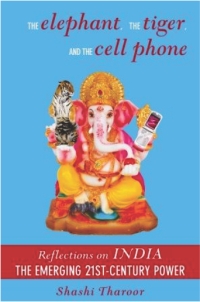| Home - Back Issues - The Team - Contact Us |
 |
| Volume 10 |Issue 46 | December 09, 2011 | |
|
|
Book Review Home Truths Zafar Anjum
In the wake of the Tehelka expose of the perpetrators of the 2002 Gujarat carnage, very few Indian writers braved the danger of inviting ridicule (from the hardliner Hindus) by penning commentaries or speaking out on this issue. Shashi Tharoor was one of them (He spoke on the issue through an interview; novelist Kunal Basu wrote a powerful piece), who is the author of the book under review. "The Elephant, The Tiger and The Cell Phone" is a collection of Tharoor's recent columns. Columnist Tharoor, who until recently was associated with the United Nations for a long time, is also a novelist. Though widely read throughout India and in many parts of the world, some don't see Tharoor as an exciting columnist, whose writings are full of "ancient platitudes, second-hand insights, and tacky witticisms." Whatever one might think of Tharoor's writings, one thing cannot be dismissed about him: His love for India (that too, a secular, pluralist India) and Indians. "My views have, over the years, earned me more than my fair share of belligerent emails and assorted Internet fulminations from the less reflective of the Hinduvta brigade," writes Tharoor. But he has learnt to take this criticism in his stride. "For Hindus like myself, the only possible idea of India is that of a nation greater than the sum of its parts," he says. In the essay, The Politics of Indentity, Tharoor underlines the difference between himself and the hardliners: "There are some like me, who are proud of Hinduism; there are others including much of the VHP (Vinshwa Hindu Parishad), who are proud of being Hindu. There is a world of difference between the two; the first base their pride on principle and belief; the second on identity and chauvinism. My Hindu pride does not depend on putting others down. Theirs, sadly, does." The part five of the book deals with the transformations that have underpinned India's globalisation and its rise as an economic power. In this part, his essays explore the rise of the Indian middle class and urban developments (call centres, IITs, IT companies, etc) that are shaping a new India. Between these two parts of the book, there are four other parts that comprise essays on variegated themes: Indians that have done the nation proud, Bollywood, NRIs and even cricket. The well-read might find some of these essays tedious, but over all, the book is an enjoyable read, in parts intellectually stimulating and witty (at least to me). But the book is not all about serious punditism. There are some essays that are quite entertaining. If you are looking for something illuminating yet light (on the mind), I will leave you with one nugget to let you decide if you want to read this book. In an essay, "India, Jones and The Temple of Dhoom," Tharoor talks about Hollywood filmmaker Steven Spielberg's cinematic success: "It has been just over two decades since that blockbuster (Indiana Jones and The Temple of Doom) swept the world's movie screens, taking boy-wonder Spielberg (who'd already gone from the dental–Jaws–to the transcendental--Close Encounters of the Third Kind) into the cinematic stratosphere."
Copyright
(R) thedailystar.net 2011 |
